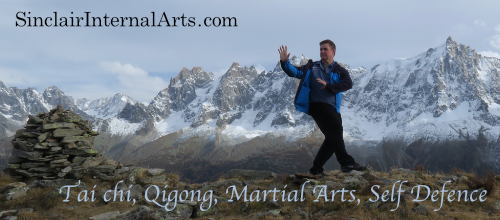In many martial arts, a fundamental training method involves set routines of martial movements, combined with stretching, balancing, breathing, meditation, and other conditioning exercises. The similarities between the routines of different styles are as numerous as their differences.
In Chinese these forms are called 套路 tàolù (set patterns). In Japanese they are called 型 “Kata” or 形 “katachi-kata”. (hirigana: かた)
In English, we use the word “Form.” The movements are sometimes thought of as a series of martial techniques. But this is inaccurate. Tai chi depends on adaptability and creativity, so training specific techniques has limited value. Techniques are practised in order to explore subtle internal principles. It can be very useful to spend some time thinking of the movements in terms of specific techniques. But ultimately this becomes limiting.
The form is not tai chi. The form is the context within which one explores the meaning of tai chi. Ultimately, the goal is to liberate oneself from the form. The process is something like this:
The student…
- has no form and no understanding of its meaning.
- learns the form and some of the techniques, but does not yet understand the method or internal meaning that makes the technique functional.
- explores the form to discover its method and meaning.
- explores the method and meaning to a degree that allows them to transcend the form.
- transcends the meaning.
New forms are created when a person masters the art and learns to express their understanding of the method and meaning in a way the is appropriate for them. The principles are universal. But each master will express those principles differently. That is why tai chi is considered both and science and an art. It is a form of self expression.
The important thing to remember is that the routine itself is not tai chi. The routine is the framework, or the context within which you practise tai chi.
There are characteristics of the choreography that will help you to improve your tai chi. The slowness, the balancing postures, the stretching, the twisting, and the positions of the arms will help to improve strength, balance, flexibility, coordination, awareness, relaxation, and much more. The routines are designed to emphasize efficiency, relaxation, and safe movement.
A teacher can help you to perform the routine in a way that gives you the maximum benefit, and will teach you principles of movement, body alignment, and leverage that you probably would not discover on your own.
Some routines are simple and brief. Some are long and complex. Some are long and simple. Some are short and profoundly complex.
For that matter, standing still is a deep and profound art that is crucial to tai chi. There are some teachers who insist that student practise standing meditation for weeks or months before they learn a routine. (Though most school start teaching a routine right at the beginning.)
I will be posting two types of videos about tai chi routines. One type will be instructional, with varying degrees of detail and depth. The other will be reference videos, which will have minimal instruction and will be most useful for those who are already learning or have learned tai chi.
Here are some videos that available now.
Reference videos
